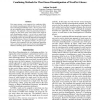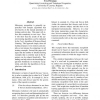119
Voted
IJCAI
2003
15 years 1 months ago
2003
We present a description of three different algorithms that use background knowledge to improve text classifiers. One uses the background knowledge as an index into the set of tra...
94
Voted
NIPS
2004
15 years 1 months ago
2004
We propose to selectively remove examples from the training set using probabilistic estimates related to editing algorithms (Devijver and Kittler, 1982). This heuristic procedure ...
100
Voted
FLAIRS
2004
15 years 1 months ago
2004
This paper presents a new approach for combining different semantic disambiguation methods that are part of a Word Sense Disambiguation(WSD) system. The way these methods are comb...
84
Voted
EACL
2006
ACL Anthology
15 years 1 months ago
2006
ACL Anthology
Metonymy recognition is generally approached with complex algorithms that rely heavily on the manual annotation of training and test data. This paper will relieve this complexity ...
SDM
2007
SIAM
15 years 1 months ago
2007
SIAM
The problem of identifying mislabeled training examples has been examined in several studies, with a variety of approaches developed for editing the training data to obtain better...
87
Voted
IJCAI
2007
15 years 2 months ago
2007
Choosing good features to represent objects can be crucial to the success of supervised machine learning algorithms. Good high-level features are those that concentrate informatio...
115
Voted
EMNLP
2007
15 years 2 months ago
2007
We propose a sequence-alignment based method for detecting and disambiguating coordinate conjunctions. In this method, averaged perceptron learning is used to adapt the substituti...
111
Voted
ICDM
2007
IEEE
15 years 2 months ago
2007
IEEE
For applications with consecutive incoming training examples, on-line learning has the potential to achieve a likelihood as high as off-line learning without scanning all availabl...
121
click to vote
AUSAI
2008
Springer
15 years 2 months ago
2008
Springer
Classifiers are traditionally learned using sets of positive and negative training examples. However, often a classifier is required, but for training only an incomplete set of pos...
96
Voted
FLAIRS
2007
15 years 2 months ago
2007
Many real-world domains present the problem of imbalanced data sets, where examples of one classes significantly outnumber examples of other classes. This makes learning difficu...





